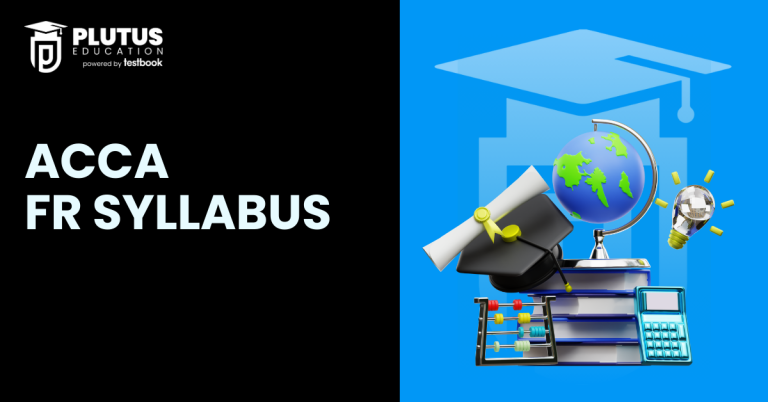The Financial Reporting (FR) paper is one of the Applied Skills level exams in the ACCA qualification. It develops students’ ability to apply accounting standards in the preparation and interpretation of financial statements for individual entities and business groups. The syllabus builds on the knowledge gained in Financial Accounting (FA) and prepares students for Strategic Business Reporting (SBR) at the professional level. The ACCA FR syllabus for 2025–26 includes updates aligned with IFRS developments and is especially relevant for Indian students familiar with Ind AS. The paper is assessed via a computer-based exam (CBE), and it also incorporates employability and digital skills. Below is a detailed syllabus breakdown from sections A to E, showing every topic and sub-topic exactly as outlined in the official ACCA study guide.
A. The Conceptual and Regulatory Framework for Financial Reporting
| Code | Sub-topic | Detailed Learning Outcomes |
| A1 | The need for a conceptual framework and the characteristics of useful information | – Explain the need for a conceptual framework. – Discuss the objectives of financial reporting. – Identify the qualitative characteristics of useful financial information. – Define recognition and measurement criteria. |
| A2 | Recognition and measurement | – Define asset, liability, equity, income, and expense. – Explain the recognition criteria for assets and liabilities. – Describe measurement bases (historical cost, current cost, fair value, etc.). |
| A3 | Regulatory framework | – Explain the roles of the IASB and ISSB. – Understand the process of developing IFRS Accounting Standards. – Distinguish between principles-based and rules-based accounting. |
| A4 | The concepts and principles of groups and consolidated financial statements | – Define a group and a subsidiary. – Understand control and its implications. – Explain the need for consolidated financial statements. – Explain the concept of an associate. |
B. Accounting for Transactions in Financial Statements
| Code | Sub-topic | Detailed Learning Outcomes |
| B1 | Tangible non-current assets | – Identify elements of cost. – Apply recognition and measurement (initial and subsequent). – Understand depreciation, revaluation, and disposal. |
| B2 | Intangible assets | – Identify internally generated intangibles. – Understand criteria for recognition and amortisation. |
| B3 | Impairment of assets | – Identify indicators of impairment. – Calculate and account for impairment losses. – Understand the concept of cash-generating units. |
| B4 | Inventories and agriculture | – Measure inventory at the lower of cost and NRV. – Account for agricultural produce. |
| B5 | Financial instruments | – Classify financial assets and liabilities. – Explain amortised cost and fair value. – Understand derecognition and factoring. |
| B6 | Leasing | – Account for leases by lessees. – Apply exemptions for low-value and short-term leases. – Understand sale and leaseback transactions. |
| B7 | Provisions and events after the reporting period | – Identify and measure provisions. – Distinguish between adjusting and non-adjusting events. |
| B8 | Taxation | – Account for current tax. – Understand the basic principles of deferred tax. |
| B9 | Reporting financial performance | – Present discontinued operations. – Account for changes in accounting policies. – Understand EPS (basic and diluted). |
| B10 | Revenue | – Apply the 5-step IFRS 15 model. – Identify performance obligations and transaction price. |
| B11 | Government grants | – Recognise and present government assistance. |
| B12 | Foreign currency transactions | – Translate foreign currency transactions. – Understand functional and presentation currency. |
C. Analysing and Interpreting the Financial Statements of Single Entities and Groups
| Code | Sub-topic | Detailed Learning Outcomes |
| C1 | Limitations of financial statements | – Discuss limitations such as estimates, historical cost, and policy changes. |
| C2 | Calculation and interpretation of accounting ratios and trends to address users’ and stakeholders’ needs | – Calculate and interpret profitability, liquidity, and solvency ratios. – Compare over time and across industry. |
| C3 | Limitations of interpretation techniques | – Discuss impact of different accounting policies. – Understand limitations of ratio analysis. |
| C4 | Not-for-profit and public sector entities | – Understand objectives and financial reporting differences in NPOs. |
D. Preparation of Financial Statements
| Code | Sub-topic | Detailed Learning Outcomes |
| D1 | Preparation of single entity financial statements | – Prepare a full set of financial statements including income statement, statement of financial position, and statement of cash flows. |
| D2 | Preparation of consolidated financial statements for a simple group | – Prepare consolidated accounts for a parent with one or more subsidiaries and an associate. – Account for goodwill, NCI, and intra-group adjustments. |
E. Employability and Technology Skills
| Code | Sub-topic | Detailed Learning Outcomes |
| E1 | Use computer technology to efficiently access and manipulate relevant information | – Use digital tools to retrieve and work with data. |
| E2 | Work on relevant response options, using available functions and technology as would be required in the workplace | – Enter answers into spreadsheet and word processing tools in the exam environment. |
| E3 | Navigate windows and computer screens to create and amend responses to exam requirements, using the appropriate tools | – Use the ACCA CBE system efficiently. |
| E4 | Present data and information effectively, using the appropriate tools | – Present answers professionally and clearly using digital formatting. |
What Changed in the 2025–26 FR Syllabus?
The FR syllabus for 2025–26 includes several important updates that affect how students prepare for the exam. These changes reflect updates in IFRS and the way ACCA frames its learning outcomes.
| Area | Change | Details |
| IFRS 18 | Replaces IAS 1 | IFRS 18, issued by the IASB, has now replaced IAS 1 as the standard for the presentation of financial statements. All formats and structures (such as the statement of profit or loss, statement of financial position, etc.) will now be examined based on IFRS 18. This impacts how students approach preparation and presentation questions. |
| IAS 1 | Removed from syllabus | IAS 1 is no longer examinable. It has been fully replaced by IFRS 18 in the ACCA syllabus from September 2025. Students should avoid referring to IAS 1 formats in practice or mock exams. |
| MPMs (Management Performance Measures) | Excluded from exam content | Although IFRS 18 introduces guidance on MPMs, ACCA has clarified that MPMs are outside the scope of the FR exam. Students do not need to study or prepare for this area in FR. |
| Learning Outcome Wording | Minor updates | Some learning outcomes have been rephrased for clarity and consistency. There are no new topics or removals (other than IAS 1), so the scope of the syllabus remains unchanged. These are cosmetic changes to improve student understanding. |
How the FR Exam is Structured
The Financial Reporting (FR) paper is examined through a Computer-Based Exam (CBE). It is designed to test your ability to apply accounting standards, interpret financial data, and present structured answers using spreadsheets and word processing tools.
| Section | Question Type | Marks |
| Section A | 15 Objective Test Questions (OTQs) | 30 marks |
| Section B | 3 Scenario-Based OTQ Cases (5 questions each) | 30 marks |
| Section C | 2 Constructed Response Questions | 40 marks |
- Duration: 3 hours exam + 10 minutes reading time
- Mode: Computer-Based Exam (CBE) only
- Pass Mark: 50%
- Question Types: Multiple Choice (OTQs), Fill in the Blank, Calculation, and Written responses using spreadsheet and word processing tools
Section A: Covers a wide range of syllabus areas with stand-alone MCQs.
Section B: Scenario-based MCQs that test interpretation and standards application.
Section C: Long-form questions requiring full financial statements, calculations, or ratio analysis.
FAQs
What is the subject of FR in ACCA?
The Financial Reporting (FR) subject focuses on preparing, presenting, and interpreting financial statements using International Financial Reporting Standards (IFRS). It includes consolidation, interpretation, and application of various accounting standards.
How to prepare for the FR ACCA exam?
To prepare effectively:
- Study the full syllabus (A to E)
- Use ACCA’s Practice Platform for CBE simulation
- Practice Section C questions on consolidation and interpretation
- Review technical articles and examiner’s reports
- Focus on IFRS 15, IFRS 16, IAS 12, and consolidated accounts
What is the 7 year rule in ACCA?
You must complete all ACCA Strategic Professional level exams within 7 years of passing your first Strategic Professional exam. If not, you’ll lose previously passed Strategic level credits.
Which is the hardest exam in ACCA?
This varies by student, but Strategic Business Reporting (SBR) and Advanced Audit and Assurance (AAA) are often considered the hardest due to their professional judgment and application focus.
Is ACCA harder than MBBS?
They are different fields. MBBS is intensive in life sciences and clinical application, while ACCA is rigorous in finance, accounting, and ethics. Each is difficult in its own domain depending on a student’s background and interest.


